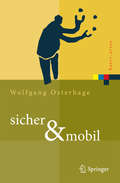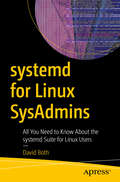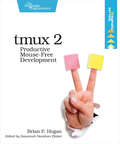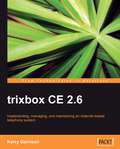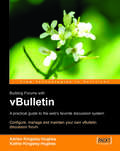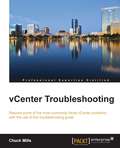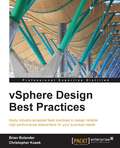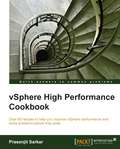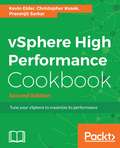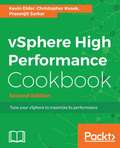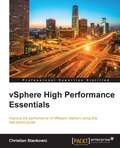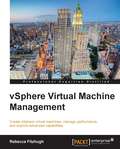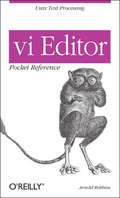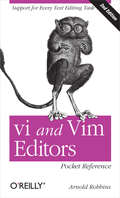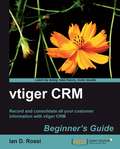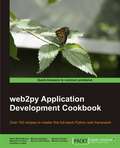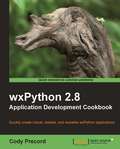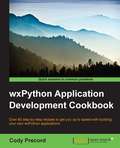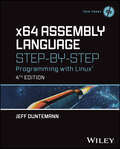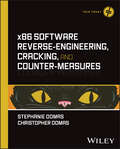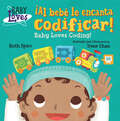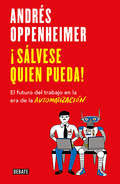- Table View
- List View
sicher & mobil
by Wolfgang W. OsterhageDie Verlinkung von Computern und ihren Komponenten hat mit den Möglichkeiten der drahtlosen Kommunikation eine neue Qualität erreicht. Die Frage, wie diese Entwicklung die IT-Sicherheit herausfordert, steht im Mittelpunkt des Buchs. Der Autor behandelt die gesamte Bandbreite der drahtlosen Kommunikation (WLAN, Bluetooth, Mobiltelefonie), liefert detaillierte Beschreibungen der Technologie, der Standards, der Verschlüsselung und Konfiguration. Der Band enthält eine Checkliste, die auf den neuesten Sicherheits- und Kommunikationsstandards basiert.
systemd for Linux SysAdmins: All You Need to Know About the systemd Suite for Linux Users
by David BothExplore the world of systemd—yes, all lower-case, even at the beginning of a sentence— which is the modern replacement for init and SystemV init scripts. It is also much more. It can evoke a wide range of reactions from SysAdmins and others responsible for keeping Linux systems up and running. The fact that systemd is taking over so many tasks in modern Linux systems has engendered push-back and discord among certain groups of developers and SysAdmins. You will learn systemd&’s strengths and weaknesses, and why there&’s no truth in the myth that systemd is a monolithic monstrosity.Learn how systemd is the mother of all processes, and is responsible for bringing the Linux host up to a state in which productive work can be done. You&’ll learn about the functions assumed by systemd, which is far more extensive than the old init program, and how it manages many aspects of a running Linux host, including: Mounting filesystems Managing hardware Creating new systemd services and understanding existing ones Creating timers that trigger system maintenance events Starting and managing the system services that are required to have a productive Linux host Using the systemd journal to access critical performance and problem solving information. Why the systemd plan to take over the world is actually a good thing systemd for Linux SysAdmins is your one-stop shop, giving you everythiing you need to get started and utilize this software suite for Linux operatiing systems. You Will Learn: How to use systemd, what it is, and what it does To manage each of the major functional components of systemd and learn from real-world examples to illustrate their typical usage by SysAdmins Pragmatic work-arounds, hints and tricks to minimize issues to ensure you have greater systemd functionality This Book is for: Linux system administrators (SysAdmins) who need to or are already in the process of switching from SystemV to systemd. It&’s also intended for SysAdmins with more systemd experience but who want to improve their knowledge and skills with systemd.
tmux 2: Productive Mouse-Free Development
by Brian P. HoganYour mouse is slowing you down. The time you spend context switching between your editor and your consoles eats away at your productivity. Take control of your environment with tmux, a terminal multiplexer that you can tailor to your workflow. With this updated second edition for tmux 2.3, you'll customize, script, and leverage tmux's unique abilities to craft a productive terminal environment that lets you keep your fingers on your keyboard's home row. You have a database console, web server, test runner, and text editor running at the same time, but switching between them and trying to find what you need takes up valuable time and breaks your concentration. By using tmux 2.3, you can improve your productivity and regain your focus. This book will show you how. This second edition includes many features requested by readers, including how to integrate plugins into your workflow, how to integrate tmux with Vim for seamless navigation - oh, and how to use tmux on Windows 10. Use tmux to manage multiple terminal sessions in a single window using only your keyboard. Manage and run programs side by side in panes, and create the perfect development environment with custom scripts so that when you're ready to work, your programs are waiting for you. Manipulate text with tmux's copy and paste buffers, so you can move text around freely between applications. Discover how easy it is to use tmux to collaborate remotely with others, and explore more advanced usage as you manage multiple tmux sessions, add custom scripts into the tmux status line, and integrate tmux with your system. Whether you're an application developer or a system administrator, you'll find many useful tricks and techniques to help you take control of your terminal.
trixbox CE 2.6
by Kerry GarrisonThis book is a step-by-step tutorial with clear instructions and screenshots to guide you through the creation of a complete, cost-effective telephony system. With its "follow-along" style, you will start with installation, walk through the different features, see how to manage and maintain the system, and finally see how all the different pieces come together. If you want to learn how to install and configure either trixbox CE systems or Asterisk-based PBX systems, without struggling with confusing configuration files and cryptic scripts, this is "the" book for you. This book will also benefit readers who use trixbox CE and want to learn all its features, and how best to use them. It is ideal for any user wishing to set up a telephony system for small business usage. No previous knowledge of Trixbox or networking is required, although some basic knowledge of PBX and Linux would be an advantage.
vBulletin: A Users Guide
by Kathy Kingsley-Hughes Adrian Kingsley-HughesUsing a highly graphical, practical style the experienced authors show you how to get the most out of vBulletin. This book is written for new and intermediate users of vBulletin, who want to manage and maintain a vBulletin discussion forum as easily as possible. No experience of web programming is required.
vCenter Troubleshooting
by Chuck MillsThe book is designed for the competent vCenter administrator or anyone who is responsible for the vSphere environment. It can be used as a guide by vSphere architects and VMware consultants for a successful vSphere solution. You should have good knowledge and an understanding of core elements and applications of the vSphere environment.
vSphere Design Best Practices
by Christopher Kusek Brian BolanderAn easytofollow guide full of handson examples of realworld design best practices. Each topic is explained and placed in context, and for the more inquisitive, there are more details on the concepts used. If you wish to learn about vSphere best practices and how to apply them when designing virtual, high performance, and reliable datacenters that support business critical applications to work more efficiently and to prepare for official certifications, then this is the book for you. Readers should possess a good working knowledge of vSphere as well as servers, storage, and networking.
vSphere High Performance Cookbook
by Prasenjit SarkarvSphere High Performance Cookbook is written in a practical, helpful style with numerous recipes focusing on answering and providing solutions to common, and not-so common, performance issues and problems.The book is primarily written for technical professionals with system administration skills and some VMware experience who wish to learn about advanced optimization and the configuration features and functions for vSphere 5.1.
vSphere High Performance Cookbook - Second Edition
by Prasenjit Sarkar Christopher Kusek Kevin ElderOver 80 recipes to help you improve vSphere 6.5's performance and solve problems before they arise About This Book • The practical recipes provide cost-effective and high performance for any application running in a virtual machine • Contains best practices and troubleshooting techniques to resolve vSphere 6.5 performance issues • Get a comprehensive coverage of performance issues and solutions including vCenter Server design and virtual machine and application tuning Who This Book Is For If you are a system administrator and are planning to deploy vSphere 6.5 in your organization and want to maximize its performance, then this book is for you. Prior knowledge of the vSphere 6.5 concepts is essential. What You Will Learn • Understand the VMM Scheduler, cache aware CPU Scheduler, NUMA aware CPU Scheduler, and more during the CPU Performance Design phase • Get to know the virtual memory reclamation technique, host ballooning monitoring, and swapping activity • Choose the right platform while designing your vCenter Server, redundant vCenter design, and vCenter SSO and its deployment • Learn how to use various performance simulation tools • Design VCSA Server Certificates to minimize security threats • Use health check tools for storage and boost vSphere 6.5's performance with VAAI and VASA In Detail vSphere is a mission-critical piece of software for many businesses. It is a complex tool, and incorrect design and deployment can create performance related issues that can negatively affect the business. This book is focused on solving these problems as well as providing best practices and performance-enhancing techniques. This edition is fully updated to include all the new features in version 6.5 as well as the latest tools and techniques to keep vSphere performing at its best. This book starts with interesting recipes, such as the interaction of vSphere 6.5 components with physical layers such as CPU, memory, and networking. Then we focus on DRS, resource control design, and vSphere cluster design. Next, you'll learn about storage performance design and how it works with VMware vSphere 6.5. Moving on, you will learn about the two types of vCenter installation and the benefits of each. Lastly, the book covers performance tools that help you get the most out of your vSphere installation. By the end of this book, you will be able to identify, diagnose, and troubleshoot operational faults and critical performance issues in vSphere 6.5. Style and approach This cookbook is written in a practical, helpful style with numerous recipes focusing on answering and providing solutions to common and not-so-common performance issues and problems.
vSphere High Performance Cookbook - Second Edition
by Kevin ElderOver 80 recipes to help you improve vSphere 6.5's performance and solve problems before they ariseAbout This Book* The practical recipes provide cost-effective and high performance for any application running in a virtual machine* Contains best practices and troubleshooting techniques to resolve vSphere 6.5 performance issues * Get a comprehensive coverage of performance issues and solutions including vCenter Server design and virtual machine and application tuningWho This Book Is ForIf you are a system administrator and are planning to deploy vSphere 6.5 in your organization and want to maximize its performance, then this book is for you. Prior knowledge of the vSphere 6.5 concepts is essential.What You Will Learn* Understand the VMM Scheduler, cache aware CPU Scheduler, NUMA aware CPU Scheduler, and more during the CPU Performance Design phase* Get to know the virtual memory reclamation technique, host ballooning monitoring, and swapping activity* Choose the right platform while designing your vCenter Server, redundant vCenter design, and vCenter SSO and its deployment* Learn how to use various performance simulation tools* Design VCSA Server Certificates to minimize security threats* Use health check tools for storage and boost vSphere 6.5's performance with VAAI and VASAIn DetailvSphere is a mission-critical piece of software for many businesses. It is a complex tool, and incorrect design and deployment can create performance related issues that can negatively affect the business. This book is focused on solving these problems as well as providing best practices and performance-enhancing techniques. This edition is fully updated to include all the new features in version 6.5 as well as the latest tools and techniques to keep vSphere performing at its best.This book starts with interesting recipes, such as the interaction of vSphere 6.5 components with physical layers such as CPU, memory, and networking. Then we focus on DRS, resource control design, and vSphere cluster design. Next, you'll learn about storage performance design and how it works with VMware vSphere 6.5. Moving on, you will learn about the two types of vCenter installation and the benefits of each. Lastly, the book covers performance tools that help you get the most out of your vSphere installation.By the end of this book, you will be able to identify, diagnose, and troubleshoot operational faults and critical performance issues in vSphere 6.5.Style and approachThis cookbook is written in a practical, helpful style with numerous recipes focusing on answering and providing solutions to common and not-so-common performance issues and problems.
vSphere High Performance Essentials
by Christian StankowicImprove the performance of VMware vSphere using this fast-paced guide About This Book * Design, configure, and monitor your virtual landscape to run performance-intensive workloads * Implement a reliable and high-performance network for virtual infrastructures with confidence. * Investigate and eliminate virtual machine performance issues Who This Book Is For If you're a system administrator who has some experience with VMware vSphere but would like a quick guide to be able to identify and fix performance issues in your vSphere systems, then this book is for you. What You Will Learn * Choose the right hardware and server components suitable for high-performance scenarios * Adopt availability and automatic load-balancing in your virtual infrastructure * Understand and monitor CPU and memory resources * Monitor performance on the vCenter, ESXi, and virtual machine levels * Configure storage resources to achieve greater performance * Incorporate latency and performance sensible networking * Tune and tweak common guest operating systems In Detail VMware vSphere is all the components and operating system that comes together to make VMware's enterprise virtualization platform unique. When running enterprise-driven application workloads, the VMware vSphere family has become a preference of many developers. The vSphere platform is designed to work with numerous servers and infrastructure core components to create virtualized platforms and/or a complete cloud computing fabrics. This book will guide you through tuning, tweaking, and optimizing vSphere in order to improve the performance of your systems. It will also help you identify and fix common performance bottlenecks. Starting with planning high-performance infrastructure setups, the book covers the core concepts of cluster setups such as resource pools, DRS, and availability options, along with CPU virtualization concepts. Next, it covers the management of physical and virtual memory mechanisms, swapping, and ballooning. Moving on, you'll get an understanding of how vCenter Server can assist you with recognizing performance issues, and how to utilize advanced technologies such as Storage I/O Control and vSphere Flash Read Cache to tune storage resources. Next, you'll learn to implement a reliable and high-performance network for virtual infrastructures. Finally, the book shows you how esxtop and resxtop can provide advanced metrics to detect performance issues, and how you can optimize storage and network resources inside virtual machines. Style and approach This book is a step-by-step guide, but at a fast pace. It explains high-performing VMware vSphere infrastructure setups and workloads through real-world examples.
vSphere Virtual Machine Management
by Rebecca FitzhughThis book follows a step-by-step tutorial approach with some real-world scenarios that vSphere businesses will be required to overcome every day. This book also discusses creating and configuring virtual machines and also covers monitoring virtual machine performance and resource allocation options. This book is for VMware administrators who want to build their knowledge of virtual machine administration and configuration. It's assumed that you have some experience with virtualization administration and vSphere.
vi Editor Pocket Reference
by Arnold RobbinsFor many users, working in the UNIX environment means using vi, a full-screen text editor available on most UNIX systems. Even those who know vi often make use of only a small number of its features.The vi Editor Pocket Reference is a companion volume to O'Reilly's updated sixth edition of Learning the vi Editor, a complete guide to text editing with vi. New topics in Learning the vi Editor include multi-screen editing and coverage of four vi clones: vim,elvis, nvi, and vile.This small book is a handy reference guide to the information in the larger volume, presenting movement and editing commands, the command-line options, and other elements of the vi editor in an easy-to-use tabular format.
vi and Vim Editors Pocket Reference: Support for every text editing task
by Arnold RobbinsMany Unix, Linux, and Mac OS X geeks enjoy using the powerful, platform-agnostic text editors vi and Vim, but there are far too many commands for anyone to remember. Author Arnold Robbins has chosen the most valuable commands for vi, Vim, and vi's main clonesâ??vile, elvis, and nviâ??and packed them into this easy-to-browse pocket reference. You'll find commands for all kinds of editing tasks, such as programming, modifying system files, and writing and marking up articles.This second edition includes:Command-line optionsvi commands and set optionsInput mode shortcutsSubstitution and regular expressionsex commands and optionsInitialization and recoveryEnhanced tags and tag stacksA greatly expanded section on Vim commands and optionsAdditional features in vile, elvis, and nviInternet resources for viA full index
vtiger CRM Beginner's Guide
by Ian D. RossiThis book covers the basics of installing and using a CRM system, explaining how to implement vtiger's powerful features for your business, adding extensions, plug-ins, and theming. It provides a step-by-step guide to installing, configuring, and customizing vtiger even at the code level, with practical advice and directions. This is book is written for IT professionals and business managers who have power-user computer skills and are looking to improve sales management processes and/or customer service processes.
web2py Application Development Cookbook
by Pablo Martin Mulone Mariano ReingartThis is a cookbook and you may read the chapters in any order. The recipes need not be read sequentially. There are a good amount of code examples and relevant screenshots to ease learning pains. The target audience are Python developers with basic knowledge of web2py who want to gain further knowledge of web2py
wxPython 2.8 Application Development Cookbook
by Cody PrecordWritten in cookbook style, this book offers learning and techniques through recipes. It contains step-by-step instructions for developers who want to build feature-rich desktop applications in wxPython. The book is designed in such a way that you can refer to things chapter by chapter, and read them in no particular order. This book is written for python programmers wanting to develop GUI applications. Basic knowledge of Python is required.
wxPython Application Development Cookbook
by Cody PrecordOver 80 step-by-step recipes to get you up to speed with building your own wxPython applications About This Book * This book empowers you to create rich cross-platform graphical user interfaces using Python * It helps you develop applications that can be deployed on Windows, OSX, and Linux * The recipes in the book involve real-world applications, giving you a first-hand experience of the practical scenarios Who This Book Is For For those who are familiar with programming in Python and want to start building applications with graphical user interfaces, this book will get you up and running quickly. A basic understanding of the Python programming language and object-oriented concepts are all that is needed. What You Will Learn * Create full featured user interfaces * Design and develop custom controls * Deploy and distribute wxPython applications to Windows, Macintosh OS X, Linux, and other UNIX-like environments * Handle and respond to application events * Manage and display data using grids * Interact with web services from your GUI * Use Paint events to draw custom displays * Support the display of user interfaces in multiple languages In Detail wxPython is a GUI toolkit for the Python programming language built on top of the cross-platform wxWidgets GUI libraries. wxPython provides a powerful set of tools that allow you to quickly and efficiently building applications that can run on a variety of different platforms. Since wxWidgets provides a wrapper around each platform's native GUI toolkit, the applications built with wxPython will have a native look and feel wherever they are deployed. This book will provide you with the skills to build highly functional and native looking user interfaces for Python applications on multiple operating system environments. By working through the recipes, you will gain insights into and exposure to creating applications using wxPython. With a wide range of topics covered in the book, there are recipes to get the most basic of beginners started in GUI programming as well as tips to help experienced users get more out of their applications. The recipes will take you from the most basic application constructs all the way through to the deployment of complete applications. Style and approach This book is a collection of step-by-step recipes that introduce the various components and concepts of wxPython in a conversational and easy-to-follow way. Each recipe contains coded examples along with detailed explanations about the key points of each topic. Each topic is designed to introduce and show you how to use a single feature from the wxPython library.
x64 Assembly Language Step-by-Step: Programming with Linux (Tech Today)
by Jeff DuntemannThe long-awaited x64 edition of the bestselling introduction to Intel assembly language In the newly revised fourth edition of x64 Assembly Language Step-by-Step: Programming with Linux, author Jeff Duntemann delivers an extensively rewritten introduction to assembly language with a strong focus on 64-bit long-mode Linux assembler. The book offers a lighthearted, robust, and accessible approach to a challenging technical discipline, giving you a step-by-step path to learning assembly code that’s engaging and easy to read. x64 Assembly Language Step-by-Step makes quick work of programmable computing basics, the concepts of binary and hexadecimal number systems, the Intel x86/x64 computer architecture, and the process of Linux software development to dive deep into the x64 instruction set, memory addressing, procedures, macros, and interface to the C-language code libraries on which Linux is built. You’ll also find: A set of free and open-source development and debugging tools you can download and put to use immediately Numerous examples woven throughout the book to illustrate the practical implementation of the ideas discussed within Practical tips on software design, coding, testing, and debuggingA one-stop resource for aspiring and practicing Intel assembly programmers, the latest edition of this celebrated text provides readers with an authoritative tutorial approach to x64 technology that’s ideal for self-paced instruction.
x86 Software Reverse-Engineering, Cracking, and Counter-Measures (Tech Today)
by Stephanie Domas Christopher DomasA crystal-clear and practical blueprint to software disassembly x86 Software Reverse-Engineering, Cracking, and Counter-Measures is centered around the world of disassembling software. It will start with the basics of the x86 assembly language, and progress to how that knowledge empowers you to reverse-engineer and circumvent software protections. No knowledge of assembly, reverse engineering, or software cracking is required. The book begins with a bootcamp on x86, learning how to read, write, and build in the assembly that powers a massive amount of the world’s computers. Then the book will shift to reverse engineering applications using a handful of industry favorites such as IDA, Ghidra, Olly, and more. Next, we move to cracking with techniques such as patching and key generation, all harnessing the power of assembly and reverse engineering. Lastly, we’ll examine cracking from a defensive perspective. Providing learners with techniques to be a better defender of their own software, or knowledge to crack these techniques more effectively. Assembly: computer Architecture, x86, system calls, building and linking, ASCII, condition codes, GDB, control flow, stack, calling conventions Reverse Engineering: reconnaissance, strings, RE strategy, stripping, linking, optimizations, compilers, industry tools Cracking: patching, key checkers, key generators, resource hacking, dependency walking Defense: anti-debugging, anti-tamper, packing, cryptors/decryptors, whitelist, blacklist, RASP, code signing, obfuscationA practical and hands-on resource for security professionals to hobbyists, this book is for anyone who wants to learn to take apart, understand, and modify black-box software. x86 Software Reverse-Engineering, Cracking, and Counter-Measures is a vital resource for security researchers, reverse engineers and defenders who analyze, research, crack or defend software applications.
xxAI - Beyond Explainable AI: International Workshop, Held in Conjunction with ICML 2020, July 18, 2020, Vienna, Austria, Revised and Extended Papers (Lecture Notes in Computer Science #13200)
by Andreas Holzinger Klaus-Robert Müller Randy Goebel Wojciech Samek Ruth Fong Taesup MoonThis is an open access book.Statistical machine learning (ML) has triggered a renaissance of artificial intelligence (AI). While the most successful ML models, including Deep Neural Networks (DNN), have developed better predictivity, they have become increasingly complex, at the expense of human interpretability (correlation vs. causality). The field of explainable AI (xAI) has emerged with the goal of creating tools and models that are both predictive and interpretable and understandable for humans. Explainable AI is receiving huge interest in the machine learning and AI research communities, across academia, industry, and government, and there is now an excellent opportunity to push towards successful explainable AI applications. This volume will help the research community to accelerate this process, to promote a more systematic use of explainable AI to improve models in diverse applications, and ultimately to better understand how current explainable AI methods need to be improved and what kind of theory of explainable AI is needed. After overviews of current methods and challenges, the editors include chapters that describe new developments in explainable AI. The contributions are from leading researchers in the field, drawn from both academia and industry, and many of the chapters take a clear interdisciplinary approach to problem-solving. The concepts discussed include explainability, causability, and AI interfaces with humans, and the applications include image processing, natural language, law, fairness, and climate science.
¡Al bebé le encanta codificar! (Baby Loves Science)
by Ruth SpiroNow available in Spanish bilingual editions, this best-selling series offers big, brainy science for the littlest listeners.Accurate enough to satisfy an expert, yet simple enough for baby, this clever board book showcases the use of logic, sequence, and patterns to solve problems. Can Baby think like a coder to fix her train? Beautiful, visually stimulating illustrations complement age-appropriate language to encourage baby's sense of wonder. Parents and caregivers may learn a thing or two, as well!Author's Note:The goal of the Baby Loves Science books is to introduce STEM topics in a developmentally appropriate way. As a precursor to learning programming languages and syntax, Baby Loves Coding presents the concepts of sequencing, problem solving, cause and effect, and thinking step-by-step. Practicing these skills early creates a solid foundation for reading, writing, math and eventually, programming.
¡Auxilio! Las redes sociales y mis hijos: Aprende a detectar los peligros
by Juan Pablo ArredondoUna guía para el cuidado de nuestros hijos en la era digital. Tarde o temprano, a todos los papás nos alcanza la modernidad. Cuando menos lo esperamos, nuestros hijos usan una serie de dispositivos electrónicos y redes sociales con los que tenemos que aprender a convivir. Este libro es una guía para entender ese mundo cuyo uso inadecuado o abuso puede ser dañino y peligroso para nuestros pequeños. Cuida a tu familia, su seguridad, su bienestar. Aquí encontrarás una guía de actividades y sugerencias para entenderlos y para generar una vida segura y tranquila.
¡Hazla en grande!
by Gary VaynerchukUna guía de vanguardia para construir tu propio camino hacia el éxito profesional y financiero. Aprende a construir tu negocio y a influir en los demás como lo hacen los grandes empresarios. Gary Vaynerchuk detalla por qué es fundamental crear una marca personal vibrante para el éxito empresarial, ofreciendo una perspectiva única sobre lo que ha cambiado con las redes sociales y qué principios son eternos. A través de historias de éxito de otros empresarios y su propia historia, explica por qué el éxito tiene mucho que ver con la comprensión de las plataformas de redes sociales y la voluntad de hacer todo lo posible para que estas herramientas funcionen a su máximo potencial. En este libro práctico, Gary analiza cada una de las principales plataformas de redes sociales para que cualquiera sepa exactamente cómo amplificar su marca personal en cada una. Ofrece consejos teóricos y tácticos sobre cómo convertirse en el más relevante en plataformas, desde las más conocidas como YouTube e Instagram, hasta las emergentes como Musical.ly. Para aquellos con más experiencia, ¡Hazla en grande! ilumina algunos matices poco conocidos y proporciona consejos innovadores y ajustes inteligentes probados para mejorar las estrategias probadas más comunes.
¡Sálvese quien pueda!: El futuro del trabajo en la era de la automatización
by Andrés OppenheimerEl 47% de los empleos será reemplazado por robots o computadoras inteligentes. ¿Quién está preparado? Con una prosa vibrante y lúcida, Andrés Oppenheimer encara un fenómeno que transformará radicalmente la sociedad: es probable que, en las próximas dos décadas, casi la mitad de los trabajos sea reemplazada por computadoras con inteligencia artificial. Abogados, contadores, médicos, comunicadores, vendedores, banqueros, maestros, obreros, restauranteros, analistas, choferes, meseros, trabajadores y estudiantes... tiemblen o prepárense. En su nueva obra, Oppenheimer -uno de los periodistas más importantes de Hispanoamérica, coganador del premio Pulitzer- detalla qué y cómo ocurrirá, a qué ritmo y qué países sufrirán más por el golpe. Y tal vez lo más importante: gracias a su investigación, realizada por tres continentes, logra explicar qué puede hacer cada uno de nosotros ante el terremoto que se acerca y enlista cuáles son los trabajos que, esos sí, tienen futuro.
